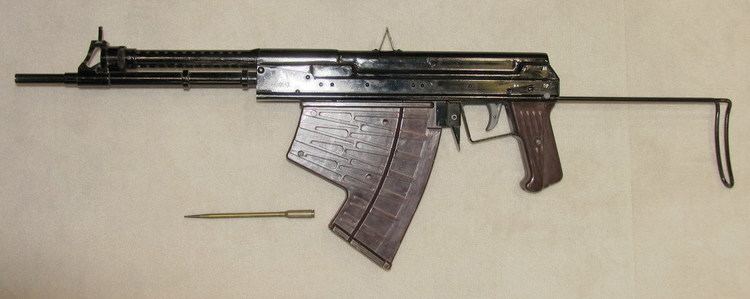 | ||
A needlegun, also known as a needler, flechette gun or fletcher, is a firearm that fires small, sometimes fin-stabilized, metal darts or flechettes.
Contents
History
The first projectiles in early gun systems dating from the 14th century were typically hand wrought iron flechettes wrapped in a leather sabot. However, due to the expense and trouble of making these darts in a pre-industrial society, they were soon replaced with the less accurate stone cannonball.
Flechettes again came into mass use in World War I, when they were dropped from airplanes.
A June 1978 issue of Gallery Magazine quotes L. Fletcher Prouty observing a test of flechette weapons in 1960 and the testimony of William E. Colby in the Church Committee on September 16 to 18, 1975 describing flechette weapons. Charles A. Senseney testified that he was a project engineer of the M-1 dart launcher that was described as resembling a M1911 pistol with a sight mount at the top.
Senseney claimed the M-1 was designed for the US Army Special Forces to be used in the Vietnam war but never got there due to not being able to get into the US Army's logistics system in time. Flechette ammunition encased in a sabot was available for the M-16, shotguns, and other weapons for use in Vietnam.
A June 1965 Esquire magazine story on the making of the then upcoming James Bond film Thunderball featured drawings of dart firing pistols that were not used in the completed film.
At the same time several makes of underwater firearms fired a steel bolt just over 4 inches long (but without fins).
The Special Purpose Individual Weapon was a long-running United States Army program to develop, in part, a workable XM-216 flechette-based "rifle", though other concepts were also involved. The concepts continued to be tested under the Future Rifle Program and again in the 1980s and 1990s under the Advanced Combat Rifle program, but neither program resulted in a system useful enough to warrant replacing the current M16.
Advantages and disadvantages
Theoretically, the advantages of a needlegun over conventional projectile firearms are in its compact size, high rate of fire, and extreme muzzle velocity. A needlegun leverages the principles of kinetic energy and conservation of momentum, resulting in a low-recoil delivery system capable of inflicting significant damage to a soft target. Although it has extreme velocity, the needle possesses little mass, delivering the equivalent kinetic energy of a larger projectile, but with less recoil-causing momentum. There have been experiments to make guided flechettes that can home in on targets.
